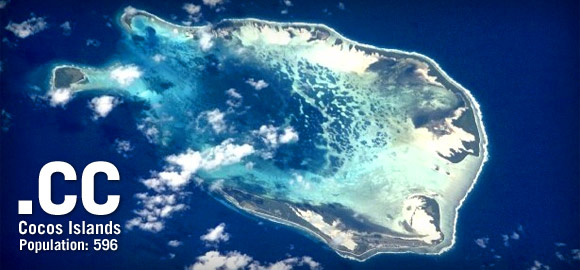
Most country code top-level domains on the Internet represent areas with millions of people, such as .uk (United Kingdom), .ca (Canada), .de (Germany), .se (Sweden), and so on, but there a places where the population isn’t counted in the millions, or even thousands, that still have their very own top-level domain on the Internet. Some of them aren’t even inhabited.
IANA, the organization that administers the domain name system, bases its allocation of country code top-level domains on the standard country code list in ISO 3166-1 which defines codes for “the names of countries, dependent territories, and special areas of geographical interest.”
The IANA is not in the business of deciding what is and what is not a country. The selection of the ISO 3166 list as a basis for country code top-level domain names was made with the knowledge that ISO has a procedure for determining which entities should be and should not be on that list. ( – Jon Postel, RFC 1591)
This has led to some really interesting situations with top-level domains (TLDs) for places where no one actually lives, or with very tiny populations.
TLDs for 10 places with tiny populations
We have sorted them by population size, smallest first.
.hm – Heard and McDonald Islands
Population: 0
A territory of Australia, the Heard and McDonald Islands is a group of barren, uninhabited volcanic islands in the middle of the ocean between Africa and Antarctica. The main reason there are any domain names registered for .hm is that it’s been marketed as a “home” address.
.pn – Pitcairn Islands
Population: 50
The Pitcairn Islands consists of four volcanic islands in the southern Pacific Ocean and is a former British colony. It’s the home of the descendants of the Bounty mutineers.
.tf – French Southern and Antarctic Lands
Population: 140
A number of islands spread over a rather large area of the Indian Ocean between Africa and Australia. There is no permanent population; merely a group of military personnel, scientists, officials and support staff.
.cc – Cocos (Keeling) Islands
Population: 596
A territory of Australia, the Cocos Islands is a group of islands located in the Indian Ocean about halfway between India and Australia. The .cc TLD is also used by the Turkish part of Cyprus, mainly because only Turkey recognizes it as a sovereign state so it won’t get its own TLD.
.va – Vatican City
Population: 826
Vatican City is of course the well-known walled city-state within Rome that serves as the high seat of the Catholic Church.
.ac – Ascension Island
Population: 940
Ascension Island is a volcanic island in the South Atlantic Ocean and is a territory of the United Kingdom. It is home to one of five ground antennas that assist in the operation of the Global Positioning System (GPS).
.aq – Antarctica
Population: 1,000 – 5,000
Antarctica has no permanent population; the only people in Antarctica are scientists living for periods of time in various research stations scattered over the continent. The .aq TLD is reserved for use by organizations that are conducting work in or promoting Antarctica.
.nu – Niue
Population: 1,398
An island nation just northeast of New Zealand, commonly known as the “Rock of Polynesia”. Since “nu” means “now” in Swedish, Danish and Dutch, .nu has been successfully marketed in Sweden, Denmark, the Netherlands and Belgium.
.tk – Tokelau
Population: 1,416
A territory of New Zealand, Tokelau consists of three islands in the southern Pacific Ocean north of New Zealand.
.io – British Indian Ocean Territory
Population: 3,500
Also known as Chagos Islands, it’s a territory of the United Kingdom. It’s a group of islands located about halfway between Africa and Indonesia. The population almost exclusively consists of a joint military outpost for the United Kingdom and United States.
Final words
Compare the above top-level domains with .in – India, population: 1.2 billion – and .cn – China, population: 1.3 billion. A wee bit of a difference. 🙂
Photo credit: Satellite photo by NASA



























